The significance of maintaining clean air ducts cannot be overstated, particularly in the context of indoor air quality and overall health. Air ducts serve as the respiratory system of a building, circulating air throughout various rooms and spaces. Over time, these ducts can accumulate dust, allergens, mold, and other contaminants that can adversely affect the air quality.
Poor air quality is linked to a range of health issues, including respiratory problems, allergies, and even chronic conditions such as asthma. When air ducts are not cleaned regularly, these pollutants can be recirculated into the living environment, exacerbating health problems and leading to discomfort for occupants. Moreover, clean air ducts contribute to the efficiency of heating and cooling systems.
When ducts are clogged with debris, the HVAC system must work harder to maintain desired temperatures, leading to increased energy consumption and higher utility bills. This inefficiency can also shorten the lifespan of the HVAC system, resulting in costly repairs or replacements. By ensuring that air ducts are clean, homeowners can not only improve their indoor air quality but also enhance the performance and longevity of their heating and cooling systems.
Regular maintenance of air ducts is thus a crucial aspect of home care that should not be overlooked.
Types of Air Duct Cleaning Equipment
High-Powered Vacuum Systems
One of the most essential tools in air duct cleaning is the high-powered vacuum system, which is crucial for removing dust and debris from ductwork. These vacuum systems are often equipped with HEPA filters that trap even the smallest particles, ensuring that contaminants do not escape back into the air during the cleaning process.
Rotary Brushes and Pneumatic Agitation Tools
In addition to vacuum systems, rotary brushes are frequently used in conjunction with vacuums to dislodge stubborn debris from duct walls. These brushes can be powered by electric motors and are designed to scrub the interior surfaces of ducts effectively. Some advanced systems also utilize pneumatic agitation tools that use compressed air to loosen dirt and debris before it is vacuumed away.
Specialized Cameras for Inspection
Furthermore, specialized cameras may be employed to inspect ductwork before and after cleaning, providing visual confirmation of cleanliness and helping technicians identify areas that require extra attention. The combination of these tools allows for a comprehensive approach to air duct cleaning.
Techniques for Maximizing Efficiency
To maximize the efficiency of air duct cleaning, technicians often employ a systematic approach that includes pre-cleaning inspections and strategic planning. Before any cleaning begins, a thorough inspection of the ductwork is essential. This inspection helps identify problem areas such as blockages or significant buildup of contaminants.
Technicians may use video inspection equipment to gain a clear view of the interior surfaces, allowing them to tailor their cleaning methods accordingly. Another technique involves using negative pressure during the cleaning process. By creating a vacuum within the duct system, technicians can ensure that any dislodged debris is immediately captured by the vacuum system rather than being released back into the air.
This method not only enhances cleaning efficiency but also minimizes the risk of cross-contamination within the home. Additionally, technicians may utilize agitation techniques such as brushing or scraping to loosen stubborn debris before vacuuming it away. By combining these methods, professionals can achieve a higher level of cleanliness in air ducts.
Benefits of Regular Air Duct Cleaning
Regular air duct cleaning offers numerous benefits that extend beyond mere aesthetics. One of the most significant advantages is improved indoor air quality. By removing dust, allergens, and other pollutants from ductwork, homeowners can breathe easier and reduce the risk of respiratory issues.
This is particularly important for individuals with pre-existing health conditions such as asthma or allergies, as clean air can significantly alleviate symptoms and enhance overall well-being. In addition to health benefits, regular cleaning can lead to substantial energy savings. When air ducts are free from obstructions, HVAC systems operate more efficiently, consuming less energy to maintain comfortable temperatures.
This efficiency translates into lower utility bills over time, making regular duct cleaning a cost-effective investment for homeowners. Furthermore, maintaining clean ducts can extend the lifespan of HVAC equipment by reducing wear and tear caused by overworking due to blockages. Ultimately, regular air duct cleaning is an essential practice for promoting both health and financial well-being.
Common Challenges in Air Duct Cleaning
Despite its importance, air duct cleaning presents several challenges that can complicate the process. One common issue is access to ductwork, particularly in older homes where ducts may be located in hard-to-reach areas such as crawl spaces or attics. In some cases, duct systems may be poorly designed or constructed, making it difficult for technicians to perform thorough cleaning without extensive modifications.
Another challenge lies in the variability of contaminants found within duct systems. Different environments may harbor unique pollutants such as pet dander, pollen, mold spores, or even construction debris from renovations. Each type of contaminant requires specific cleaning techniques and equipment to address effectively.
Additionally, some homeowners may be unaware of the need for regular cleaning or may underestimate the extent of contamination within their ducts. Educating clients about these challenges is crucial for ensuring they understand the importance of professional cleaning services.
Safety Considerations for Air Duct Cleaning
Ensuring Technician Safety
Safety is of utmost importance during air duct cleaning operations, both for technicians and homeowners. Technicians must adhere to strict safety protocols when working in confined spaces or using heavy equipment. This includes wearing appropriate personal protective equipment (PPE) such as masks, gloves, and goggles to prevent exposure to dust and allergens during the cleaning process.
Preventing Environmental Hazards
Furthermore, proper ventilation is essential when conducting air duct cleaning to avoid the buildup of harmful fumes from equipment or cleaning agents. This measure helps to prevent potential health risks associated with inhaling hazardous substances.
Homeowner Safety and Awareness
Technicians should also be trained in safe ladder usage when accessing high or difficult-to-reach areas. Homeowners should be informed about potential hazards associated with air duct cleaning and advised to vacate the premises during extensive cleaning operations if necessary. This open communication helps to ensure a safe environment for everyone involved.
Achieving a Secure Cleaning Experience
By prioritizing safety measures, both technicians and homeowners can ensure a smooth and secure cleaning experience. This collaborative approach to safety promotes a positive and risk-free air duct cleaning process.
Choosing the Right Air Duct Cleaning Equipment
Selecting appropriate air duct cleaning equipment is critical for achieving optimal results. When evaluating equipment options, factors such as suction power, filtration capabilities, and versatility should be considered. High-powered vacuums with HEPA filtration are essential for capturing fine particles and preventing them from re-entering the indoor environment during cleaning.
Additionally, technicians should assess whether their equipment can accommodate various duct sizes and configurations. For instance, flexible hoses and adjustable attachments allow for effective cleaning in tight spaces or complex duct layouts. Investing in high-quality rotary brushes and agitation tools can also enhance cleaning efficiency by ensuring thorough dislodging of debris from duct surfaces.
Ultimately, choosing the right equipment not only improves cleaning outcomes but also enhances technician productivity.
The debate between professional versus DIY air duct cleaning often hinges on factors such as cost, expertise, and effectiveness. While some homeowners may consider attempting DIY methods to save money, it is essential to recognize that professional services offer specialized knowledge and equipment that are typically beyond the reach of average consumers. Professionals are trained to identify specific contaminants and employ techniques that ensure thorough cleaning without damaging ductwork.
Moreover, DIY methods may not achieve the same level of cleanliness as professional services due to limitations in equipment and technique. For instance, while a homeowner might use a vacuum cleaner with a hose attachment to remove visible dust from vents, this approach may fail to address deeper issues within the duct system where significant buildup occurs. Additionally, professionals often provide post-cleaning inspections to verify cleanliness and ensure that all contaminants have been effectively removed.
Ultimately, while DIY options may seem appealing for their cost-effectiveness, investing in professional air duct cleaning services often yields superior results in terms of both cleanliness and health benefits.
If you are interested in learning more about how UV lights can improve the air quality in your home, check out this article on UV lights. Additionally, for information on chimney cleaning and repair services, be sure to read the articles on chimney cleaning and chimney repair. These resources can provide valuable insights into maintaining a healthy and efficient HVAC system in your home.
FAQs
What is air duct cleaning equipment?
Air duct cleaning equipment refers to the tools and machinery used to clean the HVAC (heating, ventilation, and air conditioning) system’s ductwork. This equipment includes high-powered vacuums, brushes, blowers, and other specialized tools designed to remove dust, debris, and contaminants from the ducts.
What are the common techniques used for air duct cleaning?
Common techniques for air duct cleaning include using high-powered vacuums to remove debris, using brushes and agitation devices to dislodge buildup, and employing blowers to push contaminants towards the vacuum. Some companies also use chemical treatments to help break down and remove stubborn contaminants.
Why is air duct cleaning important?
Air duct cleaning is important for maintaining indoor air quality and the efficiency of the HVAC system. Over time, dust, mold, and other contaminants can accumulate in the ductwork, leading to poor air quality and reduced system performance. Regular cleaning can help improve air quality and system efficiency.
How often should air ducts be cleaned?
The frequency of air duct cleaning depends on several factors, including the location of the property, the presence of pets, and the occupants’ sensitivities to indoor air quality. In general, it is recommended to have air ducts cleaned every 3-5 years, but some properties may require more frequent cleaning.
Can air duct cleaning equipment and techniques improve energy efficiency?
Yes, air duct cleaning equipment and techniques can improve energy efficiency by removing buildup and obstructions from the ductwork. When the ducts are clean, air can flow more freely, reducing the workload on the HVAC system and potentially lowering energy consumption.


